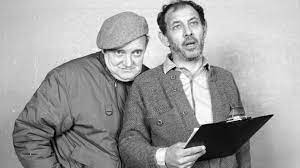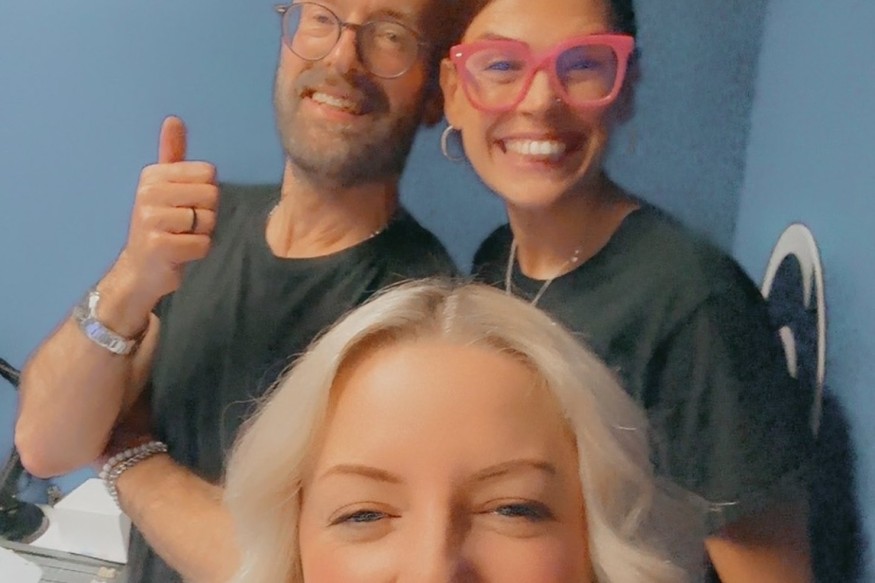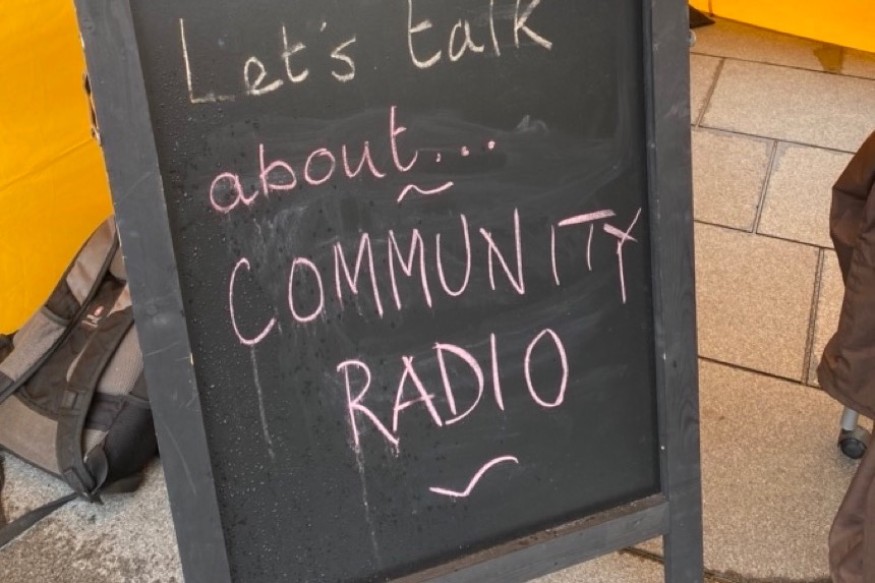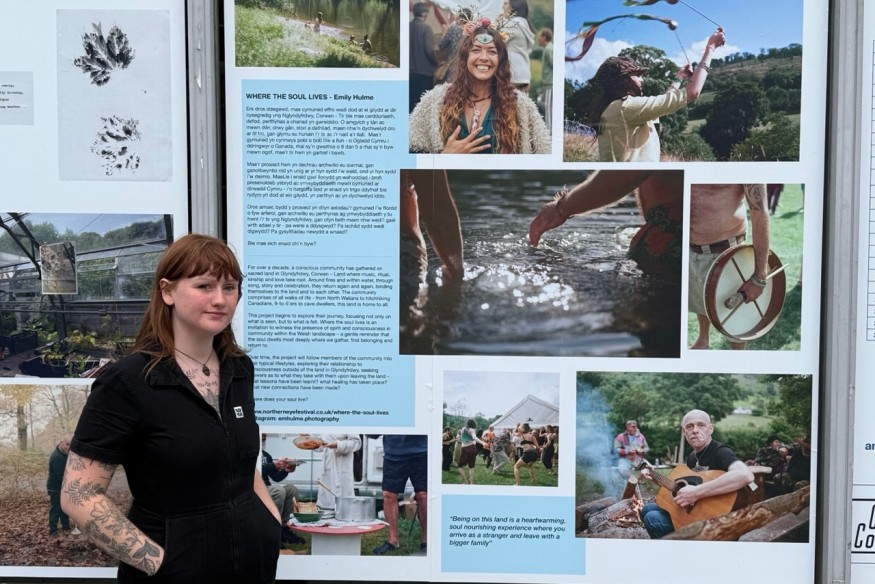The Emyr and Elwyn Story Episode 07 1986 - 2003
The company held a meeting on January 17th to discuss our ideas for 1986-87. Emyr was very keen to produce the idea based on the format, "Candid Camera". The same as the original version, the production team would create comic situations to trick the public into thinking that the situations were real. I felt that the series would be a retrograde step. I have never been comfortable with the concept of what is now known as "Reality Television". Television producers should avoid creating situations that allow Joe Public to make a fool of himself. It's so easy to do, because of the way the genre has developed since those days, Joe is more than ready to appear no matter what he has to do.
It seemed inevitable that I would fail in my attempt to encourage Emyr not to go down the "Reality" road. Everything was stacked in favour of the idea, there would be no need for guest artists, musicians or supporting artists. The series would therefore be more cost-effective than any of our previous productions. The two brothers were clearly excited and were ready to declare that the title of the series had already been decided: "Rargian Fawr!" (Good Gracious)
The other idea discussed at the same meeting was the production of a new comedy-drama with the popular character, "The Boy Scout". Emyr had already written a draft script with the title "The Holidays". But at the moment, the script was not much more than a summary, Anyway, Emyr felt that there was enough information in it to present as a commission. He was right because it was commissioned immediately.
The series, "Rargian Fawr" was supposed to start filming during the summer months, therefore, we would have to film The Boy Scout during the early weeks of spring. Also, in the summary, there were references to seaside scenes, which meant that the weather would have an influence on the film's schedule.
While Emyr was working on the script, Elwyn and I started pricing seaside locations in the United Kingdom and as our filming period was early spring, several destinations offered very reasonable deals. But the one thing that was in the back of our minds was the nature of the weather in Britain. In the television and film industry, it is possible to insure the company against anything, except the weather! If you've scheduled a day of filming on a sunny beach and the weather suddenly turns nasty, there's nothing you can do except reschedule the scene for the next day in the hope that the weather will cooperate.
Losing just one day of filming when you have employed a crew not to mention the actors would mean a significant financial loss for the company. A week later, Emyr arrived with the finished script which included not only scenes on a beach but also in several other external locations. This is when we started looking at the possibility of using a foreign location. Elwyn had studied the climate of Spain very carefully, especially the Canary Islands, which were located much further south and therefore closer to the tropics. Tenerife was a favourite mainly because Heulwen, our old friend from Rhyl who had helped organize our trip to Singapore in 1979, ran a restaurant in Las Galletas in the south of the island. We managed to contact Heulwen who did a great deal to help us to establish important contacts on the island.
After realizing that the main location of the film was Tenerife, Emyr had written scenes of the scout and his mother arriving at the airport as well as scenes featuring traditional Spanish events such as bullfighting and flamenco dancing. He had also written scenes of the scout and his mother on a campsite and a travel agent as well as the airport. While Elwyn continued to work on the budget, I worked on finding the locations in Manchester, starting at the airport.
The scenes inside the airport were relatively simple, with our characters processing through check-in, security and the departure gate. But Emyr had also written several scenes on board the plane while it was on the way to Tenerife. We worked out that it would take at least a full day to complete the scenes. We knew there was no way we could afford to hire an aircraft like an Airbus 320 or Boeing 737 for a day, so what was the alternative option?
During my time setting up the scenes at the airport, I developed a good understanding with two public relations officers, Alan McGregor, from Manchester Airport and Susan McTurk, from British Airways. Following my conversation with both, I learned that the shuttle flight from Belfast arrived at the airport at 9-00 a.m. every weekday morning. The aircraft stayed at the gate with security guards throughout the day before flying back to Belfast at 5:30 p.m. After another conversation with the airport's Security Department, we were given permission to use the plane for two days. That was a huge problem solved, thanks to the Security Department and to Alan McGregor and Susan McTurk.
I had found the other locations we needed in Manchester so the next priority was a reconnaissance visit in Tenerife. Heulwen had suggested a hotel close to her restaurant where we could stay and Elwyn had booked flight tickets from Manchester leaving at 7-10 p.m. and arriving in Tenerife at 11-40p.m. on Saturday, February 28th.
I had created a list of our priorities in Tenerife and at the top of the list was our first essential need, a translator. Our knowledge of the Spanish language was very limited. As a result, when we arrived, the first question we asked Heulwen was, "Do you know anyone who can speak English and Spanish fluently? Fortunately, she did, "He teaches English at the university in the island's capital, Santa Cruz. He is a gentleman called Joseph Morley". We contacted him and invited him to meet us for lunch the next day.
Over lunch we discovered that Joe was an English teacher from Nottingham, he had learned Spanish over several years of holidays in Spain. After losing his wife three years ago, he moved to Tenerife to continue his teaching career. Joe also knew exactly who to contact when we wanted to film in specific locations such as airports, beaches and shopping centres. There was no doubt that Joe Morley would become a valuable member of our crew.
The following day, we began our visit at the island's airport, "Aeropuerto Reina Sofia". The scenes at the airport were relatively simple, showing the characters arriving and leaving the island. Permission would, of course, be absolutely necessary. We contacted the Director of the Airport while we were still in the UK, to arrange an appointment with him to discuss our request to film at the airport. We arrived at his office with our newly appointed translator and through Joe we explained exactly what we wanted to do and where we wanted to film the scenes. The director responded positively and we promised to confirm our agreement in writing. The rest of the week was spent deciding on the locations for the scenes in the Bullring, the flamenco dance routine and the Aqua Park. We also found a reasonably priced hotel for the cast and crew. “The Marino”, in Costa del Silencio was also an ideal location for a swimming pool scene that Emyr had written. All the locations had been agreed and the mayor of the local Adeje District Council had also given us permission to film on the beach at Playa las Americas.
Our priority on our return to Colwyn Bay was to decide on the supporting cast. There were only two parts to fill, the boy scout's mother and the suspicious character who sells them the holiday and then appears in different guises throughout the film keeping an eye on them. While we were in Tenerife, Emyr had been researching possible actresses to play his mother. His favourite was an actress called Dorothea Phillips. She was in Richard Burton's version of "Under Milk Wood", in 1971, playing Mrs Dai Bread One. 'She didn't speak Welsh, but that wouldn't be a problem because Emyr had already decided that the film would have no dialogue. Dorothea, therefore became the Boy Scout's mother.
Another important role was that of the suspicious character, the man who sells them the holiday. Once again, Emyr had been looking at the list in "Spotlight", for an actor who could play a questionable character. One face stood out, the actor, Robin Griffith.
Filming was now due to start on Monday, 7th April. All the scenes in Manchester would be filmed during the first week, three days at the airport, including the scenes on board the plane and then a day at the campsite and another at the Travel Agent.
Over the weekend, we flew to Tenerife and on Monday morning we arrived at our first location, "Aeropuerto Reina Sofia". As we made our way to the "Arrival" area, two security guards blocked our way. With the help of Joe Morley, I explained that we were there to film scenes as arranged with the Airport Director. I showed them the letter I had written to him confirming our agreement. "Did you translate it?" asked Joe, "Yes!" I said, "It was translated in Colwyn Bay by a Lecturer in Spanish at Coleg Llandrillo.
Joe was furious, he demanded to see the director immediately. So, leaving the crew and actors guarded by one of the security officers, the other officer led Joe and me up one of the escalators to the top floor, where, in a huge office with a wall a whole of windows looking out over the airport, where the Director was, sitting behind a large desk.
There followed a long and complicated discussion between the director and Joseph Morley, which led to the Director demanding a sum of 100,000 pesetas in cash, (£500 at that time) before he would allow us to film at the airport. Although we had agreed on a fee when we met to discuss the filming back in March, this fee, he said, was an additional cost.
After informing the brothers of the additional payment that the director demanded, our next priority was to find a bank that would allow us to withdraw 100,000 pesetas. Back in 1986, it was not easy to transfer money from different bank accounts. Elwyn phoned our bank in Colwyn Bay, Barclays and found that they had a working relationship at the time with the Bank of Bilbao and that it was possible to make arrangements with the Las Galletas branch of the bank. Further calls were made via Colwyn Bay to Bilbao Bank HQ in Tenerife and eventually Barclays, Colwyn Bay confirmed that a transfer of £500 from the Castle Company account to the Las Galletas branch of Bilbao Bank had been made. I drove Elwyn to Las Galletas, he received the cash in a large white envelope and on his return, gave it to the Director of the airport. Filming then started two hours later than expected.
With the cooperation of the weather, the rest of the filming week went well. We were lucky to have the support of Heulwen and Joe Morley, as well as a lady by the name of Barbara Evans, who found our extra talent and took care of them. As a company, we learned a great deal about filming on the European continent. The most important lesson was: Be very careful when dealing with people in authority! "The Holiday", was broadcast on Easter Monday, 1987, at 7-15 pm on S4C.

Gari and John Ogwen
Although Emyr was very busy working on television projects in the eighties, he managed to make a few radio programs occasionally and one special series he invented with his friend, John Ogwen was, “Chwedlau Jogars” (Joggars Legends). The "Jogars" in the title was a combination of their names, John and Gari. The "Legends" were the funny stories they would tell in every program. I participated as an occasional background voice and as an accompanist. Emyr would always end each performance with a song, and "Jogars Legends " was no exception. The songs were usually connected to the tale the duo was re-telling. The songs included the duet from the opera "Hywel and Blodwen", "The Toreador Song" from the opera, "Carmen", and Roy Rogers' ode to his horse, "A Four-Legged Friend". If the song was a duet, Emyr would sing both parts wearing a different headdress depending on who was singing. This was clearly a visual joke which caused quite a reaction from the live audience at the venue. There was something special and natural about "Jogars Legends", it felt like you were listening to two old friends enjoying each other's company and in fact, that's exactly what you were doing.
1987 - 2002
After we had completed "The Holiday", the next project for the brothers was the first series of, "Rargian Fawr!" (Goodness Gracious), the Candid Camera style production. This was a sad time for me because “The Holiday” was to be my last production for the company. My involvement in Gareth Lloyd-Williams’s productions for Llifon Films took me further and further away from Cwmni’r Castell.
The company continued to produce successful light entertainment productions. “Rargian Fawr” ran for 2 more series in 1987 and 1988. In 1987, the brothers also produced a situation comedy series, “Eric”, featuring Emyr in the title role with 2 experienced supporting actors, Myfanwy Talog and Stewart Jones. In 1989, S4C commissioned a fourth series of “Galw Gari”, in the same year, I became a Media Liaison Officer and Events Organiser for the National Trust working from their north Wales office in Llandudno. During the summer of 1990, I organized a series of Orchestral concerts at 2 of the Trust’s properties, Erddig Hall in Wrexham and Powis Castle in Welshpool. It was as I was driving home from Welshpool on Wednesday, July 18th, that I turned on my car radio to hear that Emyr had died. I was so shocked I had to pull over. I'd heard he wasn't well but obviously, I didn't realize how ill he really was. Although we hadn't been as close recently, our friendship dated back to the late 1960s, and I still thought of him as a close friend.
Emyr's funeral was held on Tuesday, July 23rd, at Nazareth Chapel in Mochdre. The chapel was packed so I joined the large crowd that had gathered outside. There is no doubt that the whole of Wales was shocked by the loss of Emyr. Many tributes were paid to him not only by his friends and colleagues but also by members of the public who had never met him but had felt his loss on a personal level.
2003
Although the company had lost Emyr, Elwyn continued to work as a freelance independent producer. He also worked as a Course Organiser for “Cyfle”, the trainee programme developed by the Independent Producers Association. (Teledwyr Annibynnol Cymru) In June 2003, Elwyn suffered a cardiac arrest, leaving us far too soon. Both brothers were blessed with natural talents, Emyr as an actor, performer and communicator and Elwyn as an organizer and an analyst with boundless energy and creativity. Light entertainment in Wales has been poorer since their passing. They continue to be missed.
YouTube:
Author: Dilwyn Roberts




